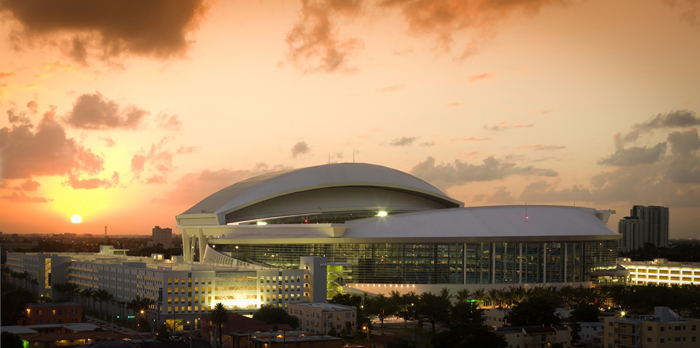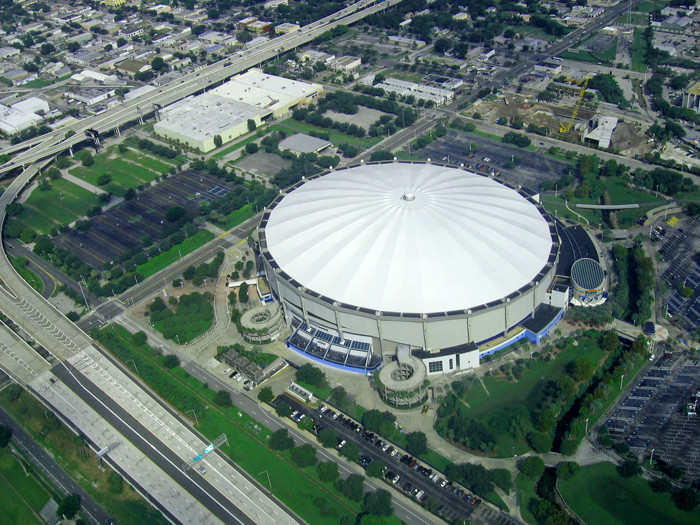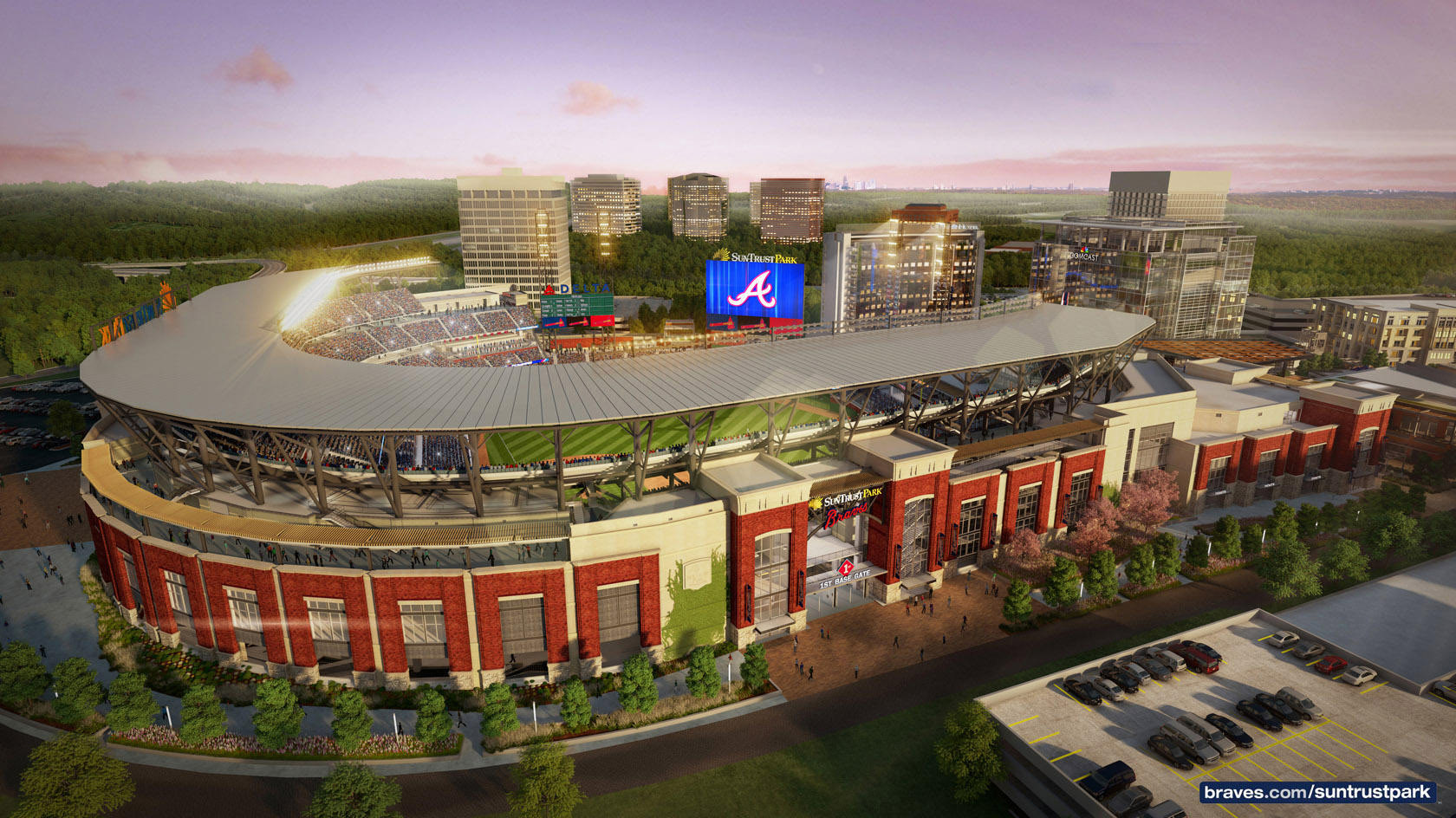Can you imagine Florida without major league baseball?

Not the spring training kind, which has been played in Florida for a century or longer, but regular season baseball.
Well, until 1993, there wasn’t any. That’s when the Florida (now Miami) Marlins were founded. Five years later, the Tampa Bay Rays, originally known as the Devil Rays, joined the Marlins.
And before the Milwaukee Braves moved down to the cookie-cutter Fulton County Stadium in Atlanta in 1966, there was no major league baseball anywhere in the Southeast.
That’s all changed now, with three teams playing in dynamically different ballparks, including the newest major league stadium, Atlanta’s SunTrust Park.
Here’s our guide to games at all three ballparks.
Tropicana Field

Home of the Tampa Bay Rays
1 Tropicana Drive, St. Petersburg
(727) 825-3137
tampabay.rays.mlb.com
119 miles from Ocala
There may be no ballpark in baseball with a worse reputation than Tropicana Field. And that reputation is, for the most part, wholeheartedly undeserved.
To say that the Trop is the best permanent domed stadium in baseball history is damning with faint praise, but it is. The park is intimate and quirky—and built for baseball, without a bad seat in the house.
History
Tropicana Field certainly has a strange backstory. It was built in the hopes of luring an existing team to relocate. In 1988, the White Sox were inches from relocating to the Florida Suncoast Dome (the Trop’s original name), and it took Illinois state legislators literally stopping the clock before midnight to negotiate terms to keep the team in Chicago. In 1991, when baseball owners voted on granting an expansion team to Florida (Miami, Orlando and Tampa all were under consideration), it was Miami that was chosen, spurring the Tampa group to sue baseball for reneging on its promise of a team. In 1992, a Tampa group purchased the San Francisco Giants to move them to the Suncoast Dome, but National League owners rejected the move by a 9-4 vote. And a year later, the Seattle Mariners appeared destined to move to St. Pete—and they had a nickname already suited for Florida!
Four times a bridesmaid, the Rays were finally born in 1995, when baseball voted to grant Tampa a franchise, to begin play in the 1998 season.
The Look
Tropicana Field was supposed to be the first ballpark covered by a soft sail/circus tent ceiling rather than a hard roof but settled for a distinctive, slanted, hard roof installed to prevent hurricane damage and reduce air-conditioning costs.
When Tropicana bought naming rights to the park in 1996, it underwent a $70 million renovation, modeled on the long-demolished Ebbets Field in New York. Most distinctive of the changes is the rotunda, made up of 1,849,091 one-inch-square tiles, greeting fans entering the park at Gate 1.
Inside the Stadium
Just inside of Gate 1, the park’s main and most vividly decorated entrance, is the Ted Williams Museum & Hitter’s Hall of Fame, relocated from Inverness. Admission is free, making it impossible to skip on a trip to the Trop. The museum is stocked with tons of memorabilia, most of which connects directly to Williams, “the greatest hitter who ever lived.”
This season begins the second decade of one of the more unique features in any ballpark, the Rays Tank in right field, which is visible from anywhere in the park. Before and during the game, fans can visit the 35-foot, 10,000-gallon tank and pet the Cownose rays—and a $5 donation to the Florida Aquarium lets you feed them.
Chow Down
If you’re looking for chow on the cheap, fans are allowed to bring their own food into the park. But there are superb choices inside.
Pipo’s Café in Section 120 and at Centerfield Street is a newcomer to the Trop, offering Cuban sandwiches, pork sandwiches, chicken paella, empanadas and fried plantains. Right Field Street offers Ricky P’s Orleans Bistro (shrimp and catfish Po Boys) and Pili’s Potatoes (gourmet baked potatoes). Hop on the Taco Bus at Centerfield Street for Mexican fare. Burger Up! in the First Base Food Court offers a Cuban Burger (ham, hamburger, salami, Swiss, mustard and pickles on toasted Cuban bread) and the Triple B sandwich with hot roast beef and fried bologna. And at the Everglades Brewhouse at Centerfield Street, sample buffalo chicken sliders, the Ripper Dog, a Smokehouse Burger or the Fan vs. Food Challenge (one pound each of brisket, pulled pork, BBQ chicken wings and fries, topped off with four slices of Texas toast), which if finished in a half-hour earns a trip to the gastrointestinologist and two free tickets to a future Rays game.
Top Seats
Attendance tends to lag at the Trop, which means you should almost always have a full selection of seats available—and yes, that means seats near home plate, along the dugouts (Lower Box Preferred). Another section with great sightlines is Press Level, with replay televisions hanging overhead. Although ticket prices aren’t yet set for 2017, in 2016, Rays tickets averaged $21. And remember, with a permanent roof and AC, every seat in the park remains dry and 72 degrees.
Did You Know?
Despite opening just 27 years ago, Tropicana Field is now the eighth-oldest ballpark in the majors. It has hosted hockey (Tampa Bay Lightning of the NHL from 1993-96), basketball (1999 NCAA Final Four), football (Tampa Bay Storm of the Arena Football League and the NCAA St. Petersburg Bowl), tennis (1990 Davis Cup), auto racing (sprint cars and monster trucks), equestrian events and rock concerts. The stadium’s attendance record is 47,150, for a New Kids on the Block concert.
Marlins Park

Home of the Miami Marlins
501 Marlins Way, Miami
(305) 480-1300
miami.marlins.mlb.com
303 Miles from Ocala
Not to pile on Florida’s ballparks, but Marlins Park came to fruition under a cloud of controversy, both for its funding and eclectic style. But as in the case of Tropicana Field, for a baseball fan, Marlins Park is a delight. There is no ballpark in the country more devoted to honoring the local flavor (Little Havana) while aspiring to artistry like this one.
History
Until this year, Marlins Park was the newest in baseball, opening in 2012. It was built on the site of the Orange Bowl, long a mainstay facility for the Miami Dolphins, NCAA football and even the minor-league baseball Marlins of the 1950s.
Permanent baseball in Miami was far from a done deal. After temporary owner John Henry sold the team to Jeffrey Loria, the Marlins set out to build a new ballpark. When financing stalled, Loria was allowed to entertain offers from other cities; he visited San Antonio, Las Vegas and Portland in the mid-2000s before serious debate over a new Miami ballpark kicked in.
The Look
Marlins Park is truly unique, the first to be built with a modern and abstract look, wholly devoted to art. Loria himself had a strong say in the overall look and individual quirks of the park, once saying that after baseball had built almost two dozen new ballparks built in the “retro” style, he wanted “something different and experimental… it was time for baseball to be innovative.”
“Loria told us to make a piece of art,” says Executive Architect Earl Santee.
Santee and his firm, Populous, did just that. Populous set out to create a park that was “quintessentially Miami” and treated the structure as a gallery space. The final design, with a white curves and glass façade, is meant to evoke water merging with land.
“The building itself is a piece of art,” says Santee.
In addition to a cutting-edge look that screams “Miami,” the ballpark received LEED Gold certification as the greenest, most sustainable ballpark in baseball upon opening (in part due to the clubhouse floors consisting of recycled athletic shoes!). Only three other parks in the majors have achieved any level of LEED certification.
With a nod to the frequent storms in South Florida, there is a retractable roof, the sixth of its kind in baseball.
Inside the Stadium
Marlins Park takes the trend of intimate stadiums to an extreme, with a capacity of 37,442 making it the third smallest in the majors.
The Rays may have a Hitter’s Museum, but the Marlins boast one honoring bobbleheads. Yeah, you read that right. Marlins Park boasts a glass enclosure in Section 15, where hundreds of bobbles (jiggled by moving shelves every minute) are on display.
And art is abundant at Marlins Park. Miami native Daniel Arsham designed one of the cleverest installations; in a nod to the Orange Bowl once standing on the site, the 10-foot high letters from the old Miami Orange Bowl sign are sunk into the concrete promenade.
Beyond the center field fence is where the lion’s share of controversy lies, the animatronic home run sculpture, designed by pop artist Red Grooms. Grooms designed the sculpture in homage to the art deco style that is cherished in Miami. The pink, blue, aqua and orange sculpture stands as tall as 75 feet, with appearances by clouds, flamingos, seagulls and palm trees. Although that description might sound like a hot mess, when Miami hits a dinger and the sculpture springs to action, it’s awe-inspiring.
Be sure to circle the 360-degree concourse once inside the park and make special note of the dual bulletproof aquarium tanks inside the walls behind home plate, containing live tropical fish. The tanks stretch a combined 60 feet and hold more than 1,000 gallons of water.
Chow Down
Debuting in 2016 was the BGR Deck in Section 19, which offers the Bash Burger, with garlic Parmesan fries. MIA BBQ in Section 24 is all about barbecue, including pulled pork, barbecued chicken, bourbon baked beans, mac and cheese, and peach cobbler. In Section 13, there’s a food truck dubbed The High Cheese offering four gourmet grilled cheese sandwiches: Brioche Triple Cheese, Pot Roast and Macaroni & Cheese, Fried Chicken and Grilled Pimento, and Fluffernutter Marshmallow Melt. Section 4’s Miami Mex offers mahi-mahi tacos and a Taco Dog (a footlong wrapped in charred tortilla, with jalapeno lime crema). For multiple choices, choose the Taste of Miami food court in Section 27, featuring eateries like Don Camaron, Latin American Café, Mama Choa and Panna Café Express, offering pork nachos, frita burgers, ceviche, minuta sandwiches, empanadas and Cuban coffee. And when it’s time for dessert, hit up Azucar Ice Cream in Section 1 for homemade Cuban ice cream from Calle Ocho in Little Havana (you also can find Calle Ocho’s Velvet Crème doughnuts throughout the park’s concession stands).
Top Seats
As at the Trop, tickets are customarily available for all Marlins games, giving fans a full selection of seats available, including Home Plate Boxes and Base Reserved seats. If you’re looking to snag a home run ball, the Clevelander beyond the left-field wall is an ideal locale—but with a nod to the South Beach vibe it invokes, you’ll have to pay an additional cover charge to get in and enjoy its great bar scene (with pool). Down the opposite line, in right field, is Section 40, G’s Corner, in honor of Marlins great Giancarlo Stanton. The section overlooks the Marlins bullpen and also features a slightly shorter outfield wall.
Although ticket prices aren’t yet set for 2017, in 2016, Marlins tickets averaged $28. And remember, with a retractable roof that is often closed (bring on the AC!), you’ll have to work to find a bad spot to watch the game.
Did You Know?
Expect a lot of vibrant colors in this year’s baseball All-Star Game uniforms, as Miami and Marlins Park hosts the Summer Classic for the first time in the city’s history. And with their World Series title in 1997 (the team added a second in 2003), the Marlins became the fastest expansion team to win a title in baseball history.
SunTrust Park

Home of the Atlanta Braves
755 Battery Ave., Atlanta
(404) 577-9100
atlanta.braves.mlb.com
377 Miles from Ocala
MLB’s newest ballpark is located 10 miles northwest of Atlanta, a continuance of the retro stadium trend that’s marked the past 25 years of baseball architecture (excepting Marlins Park).
History
Construction of SunTrust Field did not come without some controversy. Namely, Atlanta’s former park, Turner Field, was only 16 years old in 2013 when the Braves made the decision to build anew. Turner remains younger than nearly half of the ballparks active in the majors.
A key element of the Braves’s decision to build was the fact that SunTrust Field has a much larger footprint than Turner Field, allowing the team to completely develop the businesses surrounding the park. The prefab entertainment complex arising around the ballpark has already been dubbed the “Battery Atlanta.” In addition to office space, residences and hotels, Battery Atlanta will feature a rebuilt Roxy Theatre music venue as an entertainment centerpiece.
The Look
In addition to the retro feel of the park and the Battery Atlanta pop-up village surrounding it, two glass towers (a hotel and an office complex) will overlook and have views of the playing field.
Inside the Stadium
The Braves are characterizing the SunTrust experience as “the perfect marriage of classic ballpark feel, modern amenities and southern hospitality, creating a fan experience unlike any other.” That lofty goal will be aided by SunTrust’s 41,000 seats, which are 20 percent fewer than sat in Turner Field.
The park has an open concept, with very little outfield seating; four cantilevered decks of seating rise up behind home plate.
Right field at SunTrust Park will employ the Chop House, a restaurant brought north from Turner Field, as its cornerstone. The Chop House will consist of three levels, with two party decks.
Chow Down
At the Chop House in right field, fans can enjoy unique perspectives of the game while munching onconcept burgers.
Outside the park in the Battery Atlanta, several restaurants are open for pre- or postgame eats: Antico Pizza, Cru Food and Wine Bar, Tomahawk Taproom, Wahlburgers, Goldbergs Bagel Co. & Deli, Professional Bull Riders Association Bar & Grill and Superica.
Top Seats
The key objective in designing SunTrust Field was getting fans as close to the action as possible. The shortcut to that is by reducing foul territory, but SunTrust Field achieves its intimacy with some unique cantilevering of the middle and upper seating bowls—in short, even the “cheap seats” should bring fans close to the action. Fans in the upper deck will be pampered further by a large canopy shielding the sun, as well as air conditioning, an interesting choice for an open-air stadium.
Ticket prices range from $6 to $475. More than 19,000 seats will cost less than $20, and some 7,000 of those will cost less than $10. SunTrust Park will also offer roughly 6,000 seats starting at $40 that will include some form of added value (food and beverage credits, special access).
In 2016, Braves tickets averaged just more than $28, and 2017 SunTrust Park seats will average $27.73, less than the major league average of $28.94.
There promises to be a stampede for seats in any inaugural season for a ballpark, so snagging sweet SunTrust seats will prove more challenging than trips to either of Florida’s parks.
Did You Know?
Although the Braves have only played in Atlanta since 1966, the franchise is one of two remaining teams that founded the National League in 1871. The Braves began their existence as the Boston Red Stockings, eventually changing their name to the Braves. In 1953, the Braves moved to Milwaukee, before moving south 13 years later.






